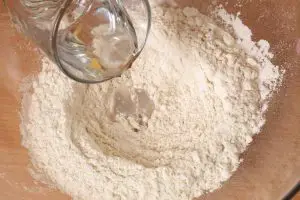Bread making can be one of the simplest and most satisfying activities to do in your spare time. It’s easy to pick up, you have delicious bread to eat afterward, and it leaves your kitchen exuding the pleasant, warm aroma of a bakery.
Plus, given that supermarket bread tends to be of lesser quality and packed with sodium, you’re doing yourself a huge favor on the health front by baking at home.
Last update on 2024-07-23 / Affiliate links / Images from Amazon Product Advertising API
You can make homemade bread in a bread machine or an oven. However, the results from each tend to be vastly different, particularly in terms of texture, taste, and appearance. In this article, we’ll run through the advantages and disadvantages of using a bread machine or an oven, and we’ll determine which of the two is the better option.
Convenience
Bread machines are designed to be a more convenient alternative to oven baking, and they certainly do cut out a lot of time and hassle. Bread machines take care of a lot of the physical aspects of bread making, such as mixing and kneading.
Plus, they also complete the rising and rest periods of the dough so that you don’t have to. Once you put the dough in the machine, you can leave it unsupervised and the machine will take care of everything for you.
With oven baking, you’re left on your own to run through the full process, including the kneading, and you’re required to keep an eye on the bread as it bakes.
Bread machines are the cleaner option, as the messy side of the baking process takes place entirely within the machine. There is minimal cleanup to do after the bread is baked, which helps save you time.
With oven baking, you are required to carry out the kneading process on a counter or board, which can leave a big mess behind. For this reason, oven baking can be particularly inconvenient, as it is time-consuming and messier.
Bread machines also have clearly labeled settings that can be manipulated easily depending on the style of bread you are making and what temperature is required. With oven baking, you’ll have to know the exact temperatures and baking times required for each bread you bake in the oven, so the risk of burning the bread is much greater.
However, with much more space available in the oven, you can bake multiple loaves of bread at one time. However, in a bread machine, you are limited to just one loaf at a time.
The Shape of the Bread
Since the kneading process takes place entirely within the bread machine, certain aspects of the shape of the finished bread are altered for this process to work smoothly. For example, to make sure that no flour gets left unused during the baking process, the corners of the bread machine pan are rounded. The result of this is strangely rounded edges on the bread, which doesn’t exactly resemble how a loaf should look.
Oven-baked loaves can produce straight edges, as the kneading process takes place outside the oven, which results in a more traditional-looking loaf.
The blades inside the bread machine also create unattractive holes along the base of the bread, which are also noticeable when you eat the bread. There are no blades involved in the oven baking process, so this is not an issue.
Texture
The texture of bread baked in a machine tends to be a lot denser than that of oven-baked bread. This is mainly due to the tight, limited space that the bread has to expand when baking.
Another reason why this happens is because the bread machine can’t preheat itself. Instead, the bread dough heats up at the same rate and therefore bakes very slowly.
This drawback also hampers the quality of the crusts, which tend to be a lot thicker, harder to cut, and even difficult to eat at times. This is a major limitation of bread machines, as there is never an option to alter the density of the bread or the thickness of the crusts.
Oven-baked bread has so much more space to rise, and you have the option to alter the density and crust of the bread. Given that oven baking allows you to preheat, you can create much lighter bread that is easier to cut than any bread you’ll ever make in a bread machine.
Problems
As mentioned earlier, one of the bread machine’s big advantages is that you can leave the bread to bake itself and that it does not require any additional supervision. However, having to supervise bread in an oven can sometimes be a blessing in disguise, as the bread can sometimes become subject to difficulties during the baking process.
The main problem involves yeast, which has a certain level of unpredictability about it that bread machines simply cannot cater to. The other ingredients in the bread and even the temperature of the machine may render the yeast useless, meaning the bread will not rise. Bread machines have no way of detecting this, so they will continue to bake the bread regardless.
With oven baking, you are required to keep an eye on the dough throughout the baking process, so you’ll be able to spot the yeast problem early and save yourself the disappointment later.
Another problem with bread machines is that they sometimes require specific ingredients, such as bread machine flour, to function at peak performance.
Conclusion
At face value, bread machines excel in the convenience department. You don’t need to keep an eye on the bread as it’s baking, you don’t need to knead the dough, and you don’t have to clean up much mess afterward. However, this apparent convenience is not all that convenient, as it’s sometimes better to keep a watchful eye over your bread to ensure that all is going well.
Overall, traditional oven baking is the better option, as you can produce several loaves at one time and it produces a better shape and texture for each loaf.









